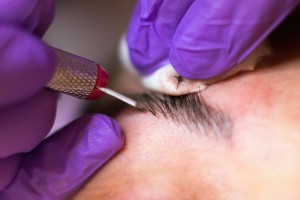 Microblading is the latest beauty fad, known to create perfect, low-maintenance eyebrows. While the semi-permanent tattooing technique can transform even bare brow bones into a shapely pair of flawless brows, microblading is a bit of an investment. Before paying hundreds, or even thousands, to alter your natural brows, it is important to do your research.
Microblading is the latest beauty fad, known to create perfect, low-maintenance eyebrows. While the semi-permanent tattooing technique can transform even bare brow bones into a shapely pair of flawless brows, microblading is a bit of an investment. Before paying hundreds, or even thousands, to alter your natural brows, it is important to do your research.
Below, we answer nine of the most frequently asked questions about microblading, to make you more comfortable with the process.
1. Is it permanent?
No. Microblading is semi-permanent, with results typically lasting between 12 and 18 months, though some clients have reported maintaining their microbladed brows for as long as three years.
“Cosmetic tattooing, unlike body art tattooing, is much more superficial to the skin,” said the ‘Eyebrow Doctor,’ Kira Tai. “The inks are also much more degradable. Your own immune system will digest the ink and also push out the pigment. Over time these looks tend to fade.”
Microblading requires touchups either yearly or bi-yearly, depending on the technician and your lifestyle. But, the look won’t last forever.
2. Is one session all it takes?
The number of sessions required to achieve the perfect brows depends on your skin, how drastic the transformation you’re hoping to achieve is, and the technician you are working with. Most people require two sessions, the initial session and a touch-up about a month later, according to Tai.
“They have to come back four weeks later, because depending on their skin type, their skin may push out a bit of ink and in some places the hair strokes won’t be as saturated as we want them,” she said. “You can tell if there’s minor imperfections after the first session that need to be filled in.”
3. Is my skin type compatible with microblading?
Very oily skin types tend to be difficult to work with, technicians have found.
“They’re at risk of rejecting the pigment, and more concerning, they are prone to pigment hydration, which is where the pigment fans into each other, the strokes sort of blend and it ends up looking like a powder-filled brow more than it looks like distinct strokes,” Tai said.
If you have skin that scars easily or retains keloids easily, microblading might not be the best option for you, either.
4. How long does the procedure take?
Most technicians need between two and three hours to complete the process. Perhaps the most tedious, but important, part of the process is drawing the brow shape on prior to the actual tattooing. Once the technician completes the shape, he or she will then work with the client to tailor the shape to their liking.
5. Will microblading give me perfectly identical brows?
“Eyebrows are sisters, not twins,” Tai emphasized. “This is very true and very important for people to understand so that they have realistic expectations. Nobody’s eyes are equidistant from the bridge of their nose so the starting points of your eyebrows are a little different.”
She added that there is a lot to account for as far as bone and facial structure, which makes it nearly impossible to achieve completely identical eyebrows, even through microblading.
6. Will it hurt?
Being that microblading is essentially a tattoo on your face, the process does involve some discomfort. Most clients, though, find the pain to be very minimal, describing it as pressure and a scratch-like sensation. Of course, pain thresholds differ from person to person, so everyone has a different experience.
Many technicians use a topical numbing gel on clients, but you can choose to have the procedure done without.
7. Will my brows lighten at all after the procedure?
Yes. When you first walk out of the salon, your eyebrows will be much darker than you anticipated, but don’t fret! The color will lighten significantly throughout the healing process.
“The first three days are the darkest days, where your eyebrows look darker,” Tai said. “By days four and five those little scabs start to fall off and by days seven and eight you can actually see the result underneath. It’s about 50 to 75 percent lighter than the day one eyebrows. The look fades significantly,” she added.
8. Can my eyebrows be fixed after the procedure?
If the technician makes a stroke that either one of you doesn’t like, it can be fixed.
“Once or twice I’ve had a client where I’ve created a stroke that I don’t like,” Tai explained. “There’s a high probability that if you don’t increase the depth of the stroke, that it might actually just fade out in the healing process. It’s best to let it fade as much as possible. Then you can go back in and neutralize it with a skin color to make the stroke disappear.”
9. How can I prepare for microblading?
This answer is simple. Do your research and talk to a microblading artist. As with any other big decision, don’t rush into anything you feel uncomfortable about. For more information regarding questions about microblading, [Click Here].
